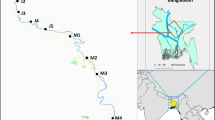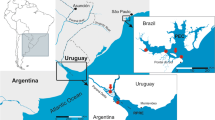Abstract
Arsenic-contaminated food including farmed fish is one of the main routes of human exposure. Fish farmed in contaminated environment accumulates arsenic in different tissues with great variability. Thus, it is utmost important to quantify the risk associated with different farmed fish species in arsenic-contaminated aquaculture systems. In the present study, arsenic content was measured in twelve fish species (Labeo rohita, L. catla, Cirrhinus mrigala, Oreochromis niloticus, O. mossambicus, Liza tade, Puntius javanicus, L. calbasu, Glossogobius giuris, Macrobrachium rosenbergii, Ctenopharyngodon idella, and Bellamya bengalensis (gastropod)) collected from arsenic-contaminated aquaculture systems. Among the studied finfishes, C. idella was found to accumulate the lowest amount of arsenic (< 0.05 ± 0.00 mg kg−1) whereas the highest accumulation was noticed in O. mossambicus (1.0 ± 0.18 mg kg−1). However, the estimated carcinogenic and non-carcinogenic risks of human were found to be low for all the studied fishes. The calculated target hazard quotient (THQ) value for adults ranged from 0.01 to 0.08 whereas for children it ranged from 0.05 to 0.27 for low-arsenic-accumulating fishes (arsenic conc. < 0.5 mg kg−1). Based on these findings, C. mrigala, C. idella, and M. rosenbergii could be recommended as the candidate species for aquaculture in the arsenic-contaminated areas as farming of the low-arsenic-accumulating food fishes would also lower the risk of human exposure through food chain.



Similar content being viewed by others
References
Ye Y, Gaugler B, Mohty M, Malard F (2020) Old dog, new trick: trivalent arsenic as an immunomodulatory drug. Br J Pharmacol 177:2199–2214. https://doi.org/10.1111/bph.15011
Mohanty BP, Mitra T, Ganguly S, Sarkar SD, Mahanty A (2020) Curcumin has protective effect on the eye lens against arsenic toxicity. Biol Trace Elem Res. https://doi.org/10.1007/s12011-020-02448-6
IARC International Agency for Research on Cancer. (2012) IARC monographs on the evaluation of carcinogenic risks to humans: a review of human carcinogens: arsenic, metals, fibres, and dusts. Lyon, France: World Health Organization; Vol. 100C
Shaji E, Santosh M, Sarath KV, Prakash P, Deepchand V, Divya BV (2021) Arsenic contamination of groundwater: a global synopsis with focus on the Indian Peninsula. Geosci Front 12:101079. https://doi.org/10.1016/j.gsf.2020.08.015
Mohanty BP, Mahanty A, Ganguly S, Mitra T, Karunakaran D, Anandan R (2019) Nutritional composition of food fishes and their importance in providing food and nutritional security. Food Chem 293:561–570
Teixeira, Mônica Cristina, Santos, Alcylane Caldeira, Fernandes, Carla Silva, Ng JC (2020) Arsenic contamination assessment in Brazil – past, present and future concerns: a historical and critical review. Sci Total Environ 730
Mohanty BP, Banerjee S, Sadhukhan P, Chowdhury AN, Golder D, Bhattacharjee S, Bhowmick S, Manna SK, Samanta S (2015) Pathophysiological changes in rohu (Labeo rohita, Hamilton) fingerlings following arsenic exposure. Natl Acad Sci Lett 38(4):315–319
Banerjee S, Mahanty A, Mohanty S, Mazumder DG, Cash P, Mohanty BP (2017) Identification of potential biomarkers of hepatotoxicity by plasma proteome analysis of arsenic-exposed carp Labeo rohita. J Hazard Mater 336:71–80. https://doi.org/10.1016/j.jhazmat.2017.04.054
AnvariFar H, Amirkolaie AK, Jalali AM, Miandare HK, Sayed AH, Sema IU, Ouraji H, Ceci M, Romano N (2018) Environmental pollution and toxic substances: cellular apoptosis as a key parameter in a sensible model like fish. Aquat Toxicol 204:144–159. https://doi.org/10.1016/j.aquatox.2018.09.010
Banerjee S, Mitra T, Purohit GK, Mohanty S, Mohanty BP (2015) Immunomodulatory effect of arsenic on cytokine and HSP gene expression in Labeo rohita fingerlings. Fish Shellfish Immunol 44:43–49. https://doi.org/10.1016/j.fsi.2015.01.029
FAO (2020) The state of world fisheries and aquaculture 2020. Sustainability in action, Rome. https://doi.org/10.4060/ca9229en
Azizur Rahman M, Hasegawa H, Peter Lim R (2012) Bioaccumulation, biotransformation and trophic transfer of arsenic in the aquatic food chain. Environ Res 116:118–135. https://doi.org/10.1016/j.envres.2012.03.014
Zhang W, Huang L, Wang WX (2011) Arsenic bioaccumulation in a marine juvenile fish Terapon jarbua. Aquat Toxicol 105:582–588. https://doi.org/10.1016/j.aquatox.2011.08.009
Kumari B, Kumar V, Sinha AK, Jawaid A, Ghosh AK, Hanping W, DeBoeck G (2016) Toxicology of arsenic in fish and aquatic systems. Environ Chem Lett. https://doi.org/10.1007/s10311-016-0588-9
Quintela FM, Lima GP, Silveira ML, Costa PG, Bianchini A, Loebmann D, Martins SE (2019) High arsenic and low lead concentrations in fish and reptiles from Taim wetlands, a Ramsar site in southern Brazil. Sci Total Environ 660:1004–1014. https://doi.org/10.1016/j.scitotenv.2019.01.031
Burger J, Gaines KF, Boring CS, Stephens WL, Snodgrass J, Dixon C, McMahon M, Shukla S, Shukla T, Gochfeld M (2002) Metal levels in fish from the Savannah river: potential hazards to fish and other receptors. Environ Res 89:85–97. https://doi.org/10.1006/enrs.2002.4330
Chen CY, Folt CL (2000) Bioaccumulation and diminution of arsenic and lead in a freshwater food web. 34:3878–3884
Milošković A, Simić V (2015) Arsenic and other trace elements in five edible fish species in relation to fish size and weight and potential health risks for human consumption. Polish J Environ Stud 24:199–206. https://doi.org/10.15244/pjoes/24929
Williams L, Schoof RA, Yager JW, Goodrich-Mahoney JW (2006) Arsenic bioaccumulation in freshwater fishes. Hum Ecol Risk Assess 12:904–923. https://doi.org/10.1080/10807030600826821
USEPA (2000) Methodology for deriving ambient water quality criteria for the protection of human health. EPA-822-B-00–004. Office of Water., Washington, DC, USA.
APHA (American Public Health Association AW works A and WEF (2005) Standard methods of examination of water and wastewater, 21st ed. APHA, Washington, D. C.
USEPA (1996) Method 3050B. Acid digestion of sediments, sludges, and soils. Test methods for evaluating solid waste. USA
Suresh G, Ramasamy V, Sundarrajan M, Paramasivam K (2015) Spatial and vertical distributions of heavy metals and their potential toxicity levels in various beach sediments from high-background-radiation area, Kerala, India. Mar Pollut Bull 91:389–400. https://doi.org/10.1016/j.marpolbul.2014.11.007
Muller (1979) Schwermetalle in den sediments des Rheins-Veranderungenseitt. Umschan 79:778–783
Kumar VS, Raman RK, Talukder A, Kakati A, Bhowmick S, Manna SK, Samanta S, Mohanty BP (2020) Clinico-epidemiological study of arsenicosis in arsenic endemic areas of West Bengal. India. J Inl Fish Soc India 52:068. https://doi.org/10.47780/jifsi.52.1.2020.106546
Latimer Jr, GW (2016). Official methods of analysis of AOAC INTERNATIONAL 20th edition, Appendix D, Guidelines for collaborative study procedures to validate characteristics of a method of analysis. Gaithersburg, MD, USA.
USEPA (United States Environmental Protection Agency) (2000) Risk-based concentration table. United States Environmental Protection Agency, Philadelphia, PA, Washington DC
Salim S (2016) Fish consumption pattern in India: paradigm shifts and paradox of export trade (Fish consumption pattern in India, exports - overview). Food Beverage News 25–28
Kar S, Maity JP, Jean JS, Liu CC, Liu CW, Bundschuh J, Lu HY (2011) Health risks for human intake of aquacultural fish: arsenic bioaccumulation and contamination. J Environ Sci Health, Part A, 4529 https://doi.org/10.1080/10934529.2011.598814
FAO (Food and Agriculture Organization) Preamble and annexes (2000). Codex general standard for contaminants and toxins in food. CODEX-STAN 193–1995 (Rev.1– 1997) Joint FAO/WHO Food Standards Programme. FAO, Rome, Italy.
USEPA (United States Environmental Protection Agency) (2011). USEPA regional screening level (RSL) summary table: November 2011.
USEPA (2007). Slope factors (SF) for carcinogens from US EPA [WWW Document]. URL 474. http://popstoolkit.com/tools/HHRA/SF_USEPA.aspx
Chowdhury AN, Samanta S, Manna SK, Sharma AP, Bandopadhyay C, Pramanik K, Sarkar S, Mohanty BP (2015) Arsenic in freshwater ecosystems of the Bengal delta: status, sources and seasonal variability. Toxicol Environ Chem 97:538–551. https://doi.org/10.1080/02772248.2015.1053482
Marriott AL, Kelly TJ, Sarkar SK, Chenery SRN, Rakshit D, Bhattacharya BD, Watts MJ (2020) Elemental composition of aquaculture fish from West Bengal, India: nutrition versus food safety. Environ Geochem Health 42:1211–1228. https://doi.org/10.1007/s10653-019-00401-8
Cheng Z, Chen KC, Li KB, Nie XP, Wu SC, Wong CKC, Wong MH (2013) Arsenic contamination in the freshwater fish ponds of Pearl River Delta: bioaccumulation and health risk assessment. Environ Sci Pollut Res 20:4484–4495. https://doi.org/10.1007/s11356-012-1382-2
Barral-Fraga L, Barral MT, MacNeill KL, Martiñá-Prieto D, Morin S, Rodríguez-Castro MC, Tuulaikhuu BA, Guasch H (2020) Biotic and abiotic factors influencing arsenic biogeochemistry and toxicity in fluvial ecosystems: a review. Int J Environ Res Public Health 17:. https://doi.org/10.3390/ijerph17072331
Sarkar S (2012) Final report of NAIP sub-project ‘Arsenic in Food-Chain: Cause, Effect and Mitigation’. Bidhan Chandra Krishi Viswa Vidyalaya, Mohanpur, West Bengal, India.
Kumar B, Sajwan KS, Mukherjee DP (2012) Distribution of heavy metals in valuable coastal fishes from North East Coast of India. Turkish J Fish Aquat Sci 12:81–88. https://doi.org/10.4194/1303-2712-v12_1_10
Mukherjee DP, Bhupander K (2011) Assessment of arsenic, cadmium and mercury level in commonly consumed coastal fishes from Bay of Bengal, India. Issn 2:2224–6088
Schaller J, Brackhage C, Mkandawire M, Dudel EG (2011) Metal/metalloid accumulation/remobilization during aquatic litter decomposition in freshwater: a review. Sci Total Environ 409:4891–4898. https://doi.org/10.1016/j.scitotenv.2011.08.006
Tomojiri D, Musikasinthorn P, Iwata A (2019) Food habits of three non-native cichlid fishes in the lowermost Chao Phraya River basin, Thailand. J Freshw Ecol 34:419–432. https://doi.org/10.1080/02705060.2019.1585392
Juncos R, Arcagni M, Rizzo A, Campbell L, Arribére M, Guevara SR (2016) Natural origin arsenic in aquatic organisms from a deep oligotrophic lake under the influence of volcanic eruptions. Chemosphere 144:2277–2289
Jia Y, Wang L, Li S, Cao J, Yang Z (2018) Species-specific bioaccumulation and correlated health risk of arsenic compounds in freshwater fish from a typical mine-impacted river. Sci Total Environ 625:600–607. https://doi.org/10.1016/j.scitotenv.2017.12.328
Dovick M, Kulp T, Arkle R, Pilloid D (2015) Ecological partitioning of arsenic and antimony in a freshwater ecosystem impacted by mine drainage. Environ Chem Chem 13:149–159
Sarret G, Guedron S, Acha D, Bureau S, Arnaud-Godet F, Tisserand D, Goñi-Urriza M, Gassie C, Duwig C, Proux O, Aucour AM (2019) Extreme arsenic bioaccumulation factor variability in Lake Titicaca, Bolivia. Sci Rep 9:1–12. https://doi.org/10.1038/s41598-019-47183-8
Dietrich M, Ayers J (2021) Geochemical partitioning and possible heavy metal(loid) bioaccumulation within aquaculture shrimp ponds. Sci Total Environ 788:147777. https://doi.org/10.1016/j.scitotenv.2021.147777
Culioli JL, Calendini S, Mori C, Orsini A (2009) Arsenic accumulation in a freshwater fish living in a contaminated river of Corsica, France. Ecotoxicol Environ Saf 72:1440–1445. https://doi.org/10.1016/j.ecoenv.2009.03.003
Erickson RJ, Mount DR, Highland TL, Hockett JR, Leonard EN, Mattson VR, Dawson TD, Lott KG (2010) Effects of copper, cadmium, lead, and arsenic in a live diet on juvenile fish growth. Can J Fish Aquat Sci 67:1816–1826. https://doi.org/10.1139/F10-098
Guha Mazumder D, Dasgupta UB (2011) Chronic arsenic toxicity: studies in West Bengal, India. Kaohsiung J Med Sci 27:360–370. https://doi.org/10.1016/j.kjms.2011.05.003
Oliveira LHB, Oliveira A, Nogueira ARA, Gonzalez MH (2017) Evaluation of distribution and bioaccumulation of arsenic by ICP-MS in tilapia. J Brazil Chem Soc 28:2455–2463
Acknowledgements
The authors would like to acknowledge fish farmers of Basirhat, West Bengal, for their cooperation and support during the sampling. Mr. Jagadish, a fish farmer from Adhani, West Bengal, is highly acknowledged. Mr. Rabuil Sk, Senior Technical Assistant, and Sujoy Nath and Seikh Sheriff are also acknowledged for their support during sampling. The authors are also thankful to Shri S. K. Sahu, Senior Scientist, FRAI Division, ICAR-CIFRI, and Dr. Manisha Bhor, Young Professional- II, ICAR-CIFRI, for their help in making GIS map. The authors are very much thankful to the learned Editorial team and the unknown reviewers for their constructive criticism and valuable suggestions that helped in improving the manuscript.
Funding
Funding support was provided by Indian Council of Agricultural Research- Central Inland Fisheries Research Institute, Barrackpore, under CIFRI Core-Project No. FREM/17–20/13.
Author information
Authors and Affiliations
Contributions
Santhana Kumar V: data curation, methodology; sample analysis, original draft writing; Rohan Kumar Raman: sampling, data analysis, preparation; Anjon Talukder: sampling, sample analysis, data curation; Arabinda Mahanty: formal analysis, draft review; Dhruba Jyoti Sarkar: data analysis, draft review and editing; Basanta Kumar Das: sampling, facilities, draft reviewing; Sanjay Bhowmick: sampling, field work; Srikanta Samanta: formal analysis, draft review; Sanjib Kumar Manna: sampling, formal analysis, draft review; Bimal Prasanna Mohanty: conceptualization; lab facilities, funding acquisition; investigation; methodology; overall supervision, draft review.
Corresponding author
Ethics declarations
Conflict of Interest
The authors declare no competing interests.
Additional information
Publisher's Note
Springer Nature remains neutral with regard to jurisdictional claims in published maps and institutional affiliations.
Supplementary Information
ESM 1
(DOCX 20 kb)
Rights and permissions
About this article
Cite this article
V., S.K., Raman, R.K., Talukder, A. et al. Arsenic Bioaccumulation and Identification of Low-Arsenic-Accumulating Food Fishes for Aquaculture in Arsenic-Contaminated Ponds and Associated Aquatic Ecosystems. Biol Trace Elem Res 200, 2923–2936 (2022). https://doi.org/10.1007/s12011-021-02858-0
Received:
Accepted:
Published:
Issue Date:
DOI: https://doi.org/10.1007/s12011-021-02858-0




